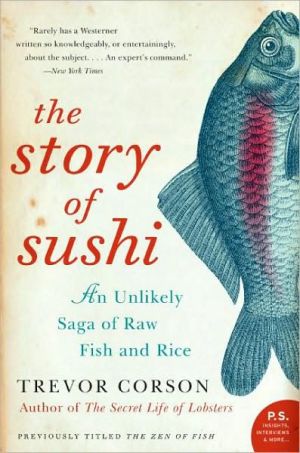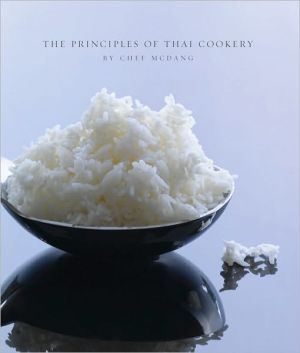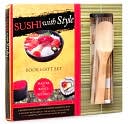Story of Sushi: An Unlikely Saga of Raw Fish and Rice
Everything you never knew about sushi—its surprising origins, the colorful lives of its chefs, and the bizarre behavior of the creatures that compose it\ \ Trevor Corson takes us behind the scenes at America's first sushi-chef training academy, as eager novices strive to master the elusive art of cooking without cooking. He delves into the biology and natural history of the edible creatures of the sea, and tells the fascinating story of an Indo-Chinese meal reinvented in nineteenth-century...
Search in google:
Everything you never knew about sushi—its surprising origins, the colorful lives of its chefs, and the bizarre behavior of the creatures that compose it Trevor Corson takes us behind the scenes at America's first sushi-chef training academy, as eager novices strive to master the elusive art of cooking without cooking. He delves into the biology and natural history of the edible creatures of the sea, and tells the fascinating story of an Indo-Chinese meal reinvented in nineteenth-century Tokyo as a cheap fast food. He reveals the pioneers who brought sushi to the United States and explores how this unlikely meal is exploding into the American heartland just as the long-term future of sushi may be unraveling. The Story of Sushi is at once a compelling tale of human determination and a delectable smorgasbord of surprising food science, intrepid reporting, and provocative cultural history. Publishers Weekly To the uninitiated, few things can be more intimidating than a sushi bar. Though the process of ordering and eating sushi isn't nearly as involved as some would think, it does require a certain amount of knowledge and etiquette to dine properly. Thankfully, Corson (The Secret Life of Lobsters) presents an exhaustive look at sushi and the chefs who prepare it that will go a long way toward instilling confidence. Alternating between the cuisine's history and the key steps in a sushi chef's education, Corson puts the reader in the thick of things à la Michael Ruhlman's Making of a Chef, detailing the laborious process of making rice, the preparation of a myriad of fish and the storied history of the California Roll. Corson covers close to 30 plants and animals over the course of the book, which becomes a bit wearying, but his structure prevents the material from overwhelming readers, and his enthusiasm for the topic is infectious-especially when the subject turns to the popularity of sushi in landlocked states or the perils of dealing with mackerel. Given the breadth and scope of the book (a bibliography and source list are included), Corson has created what could be the definitive work on the topic, enabling customers to comfortably and confidently stride into a sushi restaurant and order omakasewithout trepidation. Corson seems to sense this, as an addendum regarding sushi bar etiquette closes with the admonishment, "Most experts agree on one thing. Customers who show off their sushi knowledge are tiresome. Chefs appreciate customers who would rather eat sushi than talk about it." (June)Copyright 2007 Reed Business Information
The Zen of Fish\ The Story of Sushi, from Samurai to Supermarket \ \ By Trevor Corson \ HarperCollins\ Copyright © 2007 Trevor Corson\ All right reserved.\ ISBN: 978-0-06-088350-8 \ \ \ \ Chapter One\ SUSHI SCHOOL \ Kate Murray's alarm clock went off at 5:30 a.m. She forced her eyes open. Her college classes had never started before noon.\ The day before-the Fourth of July 2005-Kate had loaded her Mustang and driven up the coast from San Diego to Los Angeles. Now unopened boxes sat scattered around the little house. She still had no furniture, and she missed her dog.\ Kate dragged herself out of bed. In the bathroom mirror she looked skinny. The weeks leading up to sushi school had been stressful, and she'd stopped eating again.\ On the drive to the academy she hit L.A. traffic. By the time she finally reached Hermosa Beach, she was running late. Fit-looking people on Rollerblades glided down the strip along the sandy beach, and several surfers were already out testing the waves. The Pacific Ocean stretched to the horizon. A block from the beach, Kate located the Hama Hermosa sushi restaurant and hurried inside.\ She entered the foyer and saw a small dining room on her left with tables, a couple of booths, and a shiny red sushi bar. The restaurant appeared to be deserted, except for a gold Buddha sitting in an alcove.\ Through a cutout in the hallway wall Kate glimpsed people. She followed the hall and stepped into a large space with a high ceiling and skylights. A second red sushi bar ran across the back wall. Down the center of the room stretched a stainless-steel table with sinks built into it, like in a chemistry lab.\ All eyes turned and looked at Kate. Her classmates had already taken all the spots at the table, except for the one closest to the Japanese chef at the head of the table. Crap, Kate thought. She walked up to the remaining space. Everyone was standing. There were no chairs.\ The chef was a short man with a shaved head. He introduced himself as Toshi Sugiura, chief executive officer (CEO) of the California Sushi Academy. He was also executive chef of the Hama Hermosa restaurant. The restaurant and the academy shared the building.\ Toshi was a pioneer of American sushi. He had started serving sushi in Los Angeles in 1978, before most Americans had even heard of it. Throughout the 1980s and early 1990s, Toshi's sushi bar and restaurant-Hama Venice, in Venice Beach, just south of Santa Monica-had been one of the hottest sushi spots in all of L.A. Two years ago Toshi had shifted his efforts to the current restaurant, and it hadn't been long before Phil Jackson, coach of the L.A. Lakers, had stopped by to inscribe his signature on the wall.\ Toshi had founded the California Sushi Academy in 1998. Opening a school for sushi chefs was unprecedented. For nearly 200 years, becoming a sushi chef had required a long apprenticeship-often five or more years. Toshi wanted to train people in a few months.\ Toshi hired staff to manage the school and to teach. When the academy opened, three-quarters of the applicants were not even Asian. Toshi accepted them all. He couldn't be certain, but he assumed that many of his fellow Japanese sushi chefs considered him a traitor for welcoming outsiders into the world of sushi. The way Toshi saw it, Americans had already embraced sushi, and it would be foolish not to train American chefs. Since then, a few other sushi schools had opened in L.A., including the Sushi Chef Institute, run by a former instructor at Toshi's academy. So far, these were the only formal training programs for sushi chefs in the United States.\ Anyone could apply to the California Sushi Academy. Toshi didn't require his students to have restaurant or kitchen experience. Hobbyists and home cooks had attended the school, along with experienced chefs, including seasoned veterans of some of America's best kitchens. Not all of the graduates went on to become professional sushi chefs. Over the years, the proportion of non-Asian students had remained high.\ 'Ohaiyõ gozaimasu!' Toshi bellowed to the class. This meant "Good morning" in Japanese. But around the restaurant, the chefs said it whenever they arrived for work, even if it was afternoon or evening.\ Toshi taught the class another word. 'Irasshaimase!' That meant "Welcome." Sushi chefs yelled it whenever a customer walked in. Most Americans thought Japanese people were supposed to act quiet and dignified. But in old Tokyo, sushi chefs were loud and boisterous.\ Kate liked Toshi immediately. He was cheerful and stern at the same time, like a monk who was also a kung-fu warrior. Toshi asked the nine students to introduce themselves. Kate looked around at the people who would be her classmates for the next twelve weeks. There were six men and two other women. It had never occurred to her that most of her classmates would be men. It hadn't occurred to her that there was anything unusual about a woman, or her in particular, wanting to become a sushi chef. Kate didn't see why a 20-year-old Irish-Italian girl with a pierced belly button and a nose stud couldn't make sushi.\ The other students were also young, and a majority of them were white. They had come to the academy for a variety of reasons. Most of them had restaurant kitchen experience, and a few already had experience making sushi. Kate had neither.\ One young man had made his start mass-producing sushi at a Whole Foods grocery store in North Carolina, and he wanted to move up to restaurant work. Another had seen how widespread sushi had become, and he hoped to purchase his own sushi restaurant in southern California. A man from El Paso, Texas, had been sent by his company, a real-estate and restaurant-development firm, because sushi was the hot new meal on the Mexican border.\ (Continues...)\ \ \ \ \ Excerpted from The Zen of Fish by Trevor Corson Copyright © 2007 by Trevor Corson . Excerpted by permission.\ All rights reserved. No part of this excerpt may be reproduced or reprinted without permission in writing from the publisher.\ Excerpts are provided by Dial-A-Book Inc. solely for the personal use of visitors to this web site. \ \
Week 1Sushi School 3Eating to Live 10Mold 13Week 2Taste of the Sea 21Like the Vomit of a Drunkard 25Seven Gods in Every Grain 33L.A. Story 44Battle of the Sexes 52Hollywood Showdown 60Weeks 3, 4, and 5Chef's Choice 75Inside the Roll 81Putting On the Squeeze 89Fast Food 94American Style 98Show Time 102Fruits of the Sea 108Blood and Guts 113Eat the Pie 120Big Test 123Week 6Sushi Nation 131Manhood of Shrimp 136Getting Fishy 142Raw Deal 149Mackerel Gal 153Russian Roulette 158Tastes Like Chicken 164Mango Love 166Comedy Club 169Week 7Long Good-Bye 175From Freshwater 178Congratulations Fish 186Unleash the Beast 197Flatfish 206Old Glory 214Spy Kids 216Week 8Sea Snakes 225Tentacles of the Deep 232Giant Clam 240Final Fish 245Carving the Mountain 252Sushi Kung Fu 258Mortal Combat 264Drunken Master 270Weeks 9 and 10Eggs and Ovaries 277Weeks 11 and 12Last Dance 287Deli 292Sushi Master 294Pizza Party 301EpilogueHomecoming 309One Year Later 315How to Eat Sushi 317Acknowledgments 323Source Notes 329Glossary of Selected Japanese Terms 341Bibliography 345Index 363
\ From Barnes & NobleTo write his previous book, Atlantic Monthly regular Trevor Corson trailed lobster fishermen and scientists. Now the author of The Secret Life of Lobsters adjusts his focus to the stylish fare of sushi. In The Zen of Fish, he shares the rigorous, samurai-like training of aspiring chefs at America's first sushi training academy in Los Angeles. Along the way, Corson also wades into little-known aspects of fish biology, the Japanese food economy, and the thriving sushi trade. An appealing appetizer for any one who has savored Asian cuisine.\ \ \ \ \ Natural History Magazine"One of the best things you can enjoy without melted butter."\ \ \ Eric Ripert"Trevor Corson’s reverence for all things from the sea is palpable. In his new book The Zen of Fish he takes you on a fascinating journey into the world of sushi. The story he relates is rich in detail, thoroughly engaging, simply a pleasure to get lost in."\ \ \ \ \ Michael Ruhlman"The Zen of Fish is a pleasure to read, entertaining and informative, with compelling characters and fascinating history, all told in an easy and natural voice. Excellent food journalism."\ \ \ \ \ New York Times Book Review"Authoritative, often amusing, chapters on sushi history, marine biology and the physiognomy of taste. While the students hack away at mackerel, Corson serves up bite-size explanations. . . . His chapter on rice, a subject that Americans take for granted, is itself worth the price of the book."\ \ \ \ \ New York Times"Rarely has a Westerner written so knowledgeably, or entertainingly, about the subject. . . . The reader emerges not only enlightened but a much better sushi eater.\ \ \ \ \ Natural History magazine“One of the best things you can enjoy without melted butter.”\ \ \ \ \ USA Today“A fascinating story, blending science, politics and history . . . the writing is vivid.”\ \ \ \ \ Boston Herald“Corson serves up a savory blend of history and science along with a satisfying course of lobster and human behavior.”\ \ \ \ \ San Francisco Chronicle Book Review"[The reporting] technique creates an immediate (and lasting) respect for the author’s narrative purity. . . . Corson also possesses a touch of the poetic."\ \ \ \ \ Time Out New YorkIlluminating new book...\ \ \ \ \ PenthouseCorson leaves no detail unexplained, and true food nerds will appreciate his rigor....fascinating....you’ll still be lining up to order your favorite snack, but with renewed appreciation.\ \ \ \ \ Boston Globe"The Zen of Fish" tells us everything we could possibly want to know about every aspect of sushi.\ \ \ \ \ Entertainment Weekly"Modest, unpretentious, and personal—it offers the familiar comfort of an omakase lunch…"\ \ \ \ \ Wall Street Journal"Corson garnishes the tale with plenty of interesting tidbits. . . . Sushi fans may devour the information in The Zen of Fish."\ \ \ \ \ Solares Hill Key West"Since sushi has become so popular in America, [Trevor Corson’s book] The Zen of Fish is now as relevant to the average American diner as other popular works of food-related journalism like Eric Schlosser’s ‘Fast Food Nation’ or Michael Pollan’s ‘The Omnivore’s Dilemma.’"\ \ \ \ \ San Francisco Chronicle"A quirky, humanistic and mostly non-linear approach to the story of sushi. . . . poetic . . . beautiful."\ \ \ \ \ Los Angeles Times"Lively. . . . vivid mixture of history, science, and personal anecdotes."\ \ \ \ \ Seattle Post-Intelligencer"A meticulously reported account. . . . Corson proves a master at providing a non-stop banquet of tasty morsels sure to delight anyone who has taken a seat at a sushi bar."\ \ \ \ \ Boston Herald on The Secret Life of Lobsters“Corson serves up a savory blend of history and science along with a satisfying course of lobster and human behavior.”\ \ \ \ \ USA Today on The Secret Life of Lobsters“A fascinating story, blending science, politics and history . . . the writing is vivid.”\ \ \ \ \ Entertainment Weekly“Modest, unpretentious, and personal—it offers the familiar comfort of an omakase lunch…”\ \ \ \ \ New York Times“Rarely has a Westerner written so knowledgeably, or entertainingly, about the subject. . . . The reader emerges not only enlightened but a much better sushi eater.\ \ \ \ \ Los Angeles Times“Lively. . . . vivid mixture of history, science, and personal anecdotes.”\ \ \ \ \ Wall Street Journal“Corson garnishes the tale with plenty of interesting tidbits. . . . Sushi fans may devour the information in The Zen of Fish.”\ \ \ \ \ PenthouseCorson leaves no detail unexplained, and true food nerds will appreciate his rigor....fascinating....you’ll still be lining up to order your favorite snack, but with renewed appreciation.\ \ \ \ \ San Francisco Chronicle“A quirky, humanistic and mostly non-linear approach to the story of sushi. . . . poetic . . . beautiful.”\ \ \ \ \ Boston Globe“The Zen of Fish” tells us everything we could possibly want to know about every aspect of sushi.\ \ \ \ \ New York Times Book Review“Authoritative, often amusing, chapters on sushi history, marine biology and the physiognomy of taste. While the students hack away at mackerel, Corson serves up bite-size explanations. . . . His chapter on rice, a subject that Americans take for granted, is itself worth the price of the book.”\ \ \ \ \ Seattle Post-Intelligencer“A meticulously reported account. . . . Corson proves a master at providing a non-stop banquet of tasty morsels sure to delight anyone who has taken a seat at a sushi bar.”\ \ \ \ \ San Francisco Chronicle Book Review“[The reporting] technique creates an immediate (and lasting) respect for the author’s narrative purity. . . . Corson also possesses a touch of the poetic.”\ \ \ \ \ Solares Hill Key West“Since sushi has become so popular in America, [Trevor Corson’s book] The Zen of Fish is now as relevant to the average American diner as other popular works of food-related journalism like Eric Schlosser’s ‘Fast Food Nation’ or Michael Pollan’s ‘The Omnivore’s Dilemma.’”\ \ \ \ \ Publishers WeeklyTo the uninitiated, few things can be more intimidating than a sushi bar. Though the process of ordering and eating sushi isn't nearly as involved as some would think, it does require a certain amount of knowledge and etiquette to dine properly. Thankfully, Corson (The Secret Life of Lobsters) presents an exhaustive look at sushi and the chefs who prepare it that will go a long way toward instilling confidence. Alternating between the cuisine's history and the key steps in a sushi chef's education, Corson puts the reader in the thick of things à la Michael Ruhlman's Making of a Chef, detailing the laborious process of making rice, the preparation of a myriad of fish and the storied history of the California Roll. Corson covers close to 30 plants and animals over the course of the book, which becomes a bit wearying, but his structure prevents the material from overwhelming readers, and his enthusiasm for the topic is infectious-especially when the subject turns to the popularity of sushi in landlocked states or the perils of dealing with mackerel. Given the breadth and scope of the book (a bibliography and source list are included), Corson has created what could be the definitive work on the topic, enabling customers to comfortably and confidently stride into a sushi restaurant and order omakasewithout trepidation. Corson seems to sense this, as an addendum regarding sushi bar etiquette closes with the admonishment, "Most experts agree on one thing. Customers who show off their sushi knowledge are tiresome. Chefs appreciate customers who would rather eat sushi than talk about it." (June)\ Copyright 2007 Reed Business Information\ \ \ \ \ Library JournalThose who have ever been curious to know the path the salmon sashimi had to take before arriving on their plates will find this book appetizing; it centers on a Los Angeles sushi school and one student's trials, in particular. Journalist Corson (The Secret Life of Lobsters) manages to illustrate the complex work of the sushi chef and the equally complex natural history of the sea creatures that became what is now an incredibly popular food at a time when many fish species may be endangered. Human interest and culinary and natural history combine to make an engaging book. The author has woven together some disparate story elements into a whole that will delight readers with a variety of interests. Recommended for most public libraries, especially those with good sushi restaurants nearby!\ —Shelley J.M. Brown\ \ \ \ \ \ Library JournalJournalist Corson (Atlantic Monthly, New York Times) follows top Japanese chefs and American newcomers to uncover the secrets of sushi. Copyright 2007 Reed Business Information.\ \








